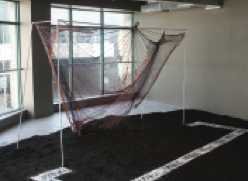Migraciones: Mirando al Sur
Arte Centro Cultural Español, Miami
The exhibition Migraciones: Mirando al Sur Arte, organized by the Spanish Cultural Center in Miami and curated by Rosina Cazali, inverted the perspective of the migratory movement in the continent that involves multitudes moving northward, and performed a sort of cultural investigation of these crossings looking southward, to the artistic practices of Central America. The Honduran artist Adán Vallecillo (and also Emilio Chapela Pérez, who was not included in this exhibit), address the subject of the great financial corporations appropriating the colors of these compamies’ logos to execute works that contain them and that formally express their social effects. Valdecillo utilizes Western Union’s yellow and grey in canvases and levels (also used in museography), and through the incorporation of forms used to measure balance, he suggests its absence. Advertisements of food products, which were hypnotic for Pop Art, incorporate iconographies of degradation. The Salvadorian Dalia Chévez superposes to the printed images imported products, corn tortillas (the sacred ancestral food) that become gradually cov- ered with fungi that eat up the pages. Lucía Madriz (Costa Rica) reconstructs corporative symbols using seeds and basic foods. The stars in her installation on a corporative “flag” are made from trans- parent plastic containers stuffed with pop corn. When they collapse, the processed corn is disseminated on the floor. As Cazali points out, this is a metaphor for the collapse of the façade of the con- sumer’s defense, and the surreptitious introduction of trans- genic crops, or the effect of negotiations about seeds on the farmers who swell the ranks of those traveling northward. Ernesto Salmerón’s video, Ellos no son pobres, shows children enjoying games in the river, while texts such as “your cell- phone” or “always selecting something that they do/ not have” are superimposed on the screen. The contraposition between imaginaries of desire and alternative ways of life tends to dis- articulate the temptation of consumerism.

The failures of modernist utopias in the cities of the south and the obstacles in social mobility within these or on the borders are also addressed in works structured on the basis of contradiction. Donna Conlon uses ants to cut the typical leaves of the disap- pearing jungles to convey symbols of globalization. Paradox is, in turn, another common sign: it can be found in the impassable labyrinths built with white threads tied to white weights by Ronald Morán (who has attributed to that color the expressive capacity of violence); in Miguel Ángel Madrigal’s scaffoldings, unfinished and fragile like invasion neighborhoods; or in the Guatemalan artist Angel Poyón’s clocks (or northless compass- es), in which time or orientation are marked − are tied − with fixed cords. Another experience that the Nicaraguan Patricia Belli reconstructs in her assemblage is the “dismantling of envi- ronments and their re-construction”, in the words of Cazali.
In Betsabée Romero’s Proyecto Porterías, the containment nets, the defense lines drawn with lime, or the tracks of tires on the dirt allude to attempts to cross over to an “other side”, which is unreachable, even when one crosses the border. While the Guatemalan group La Torana depicts constellations of the imaginaries of objects that push people to leave, Regina José Galindo’s video reproduces one of the experiences of the other side. The artist rented a cell for families similar to the ones used to confine whole families of illegal immigrants. For 24 hours, the artist confined herself there, together with her husband and her baby, reproducing the experience from which the private jail companies subsidized by the US Government profit. Another strategy is the use of documentary objects –independent of whether they are or are not fictitious – which reconstruct sto- ries of the lives of immigrants. In Retrato hablado, Danny Zavaleta reconstructs the life of a former member of the Armed Forces of El Salvador, and through it, the hisstory of a war which multiplied the number of exiles. In sum, there is a resurgence of the art of politics, which, by contrast with what occurred in the 1970s, is being constructed as a space for the observation of reality that opens gaps in this reality through a way of “narrating” it.





